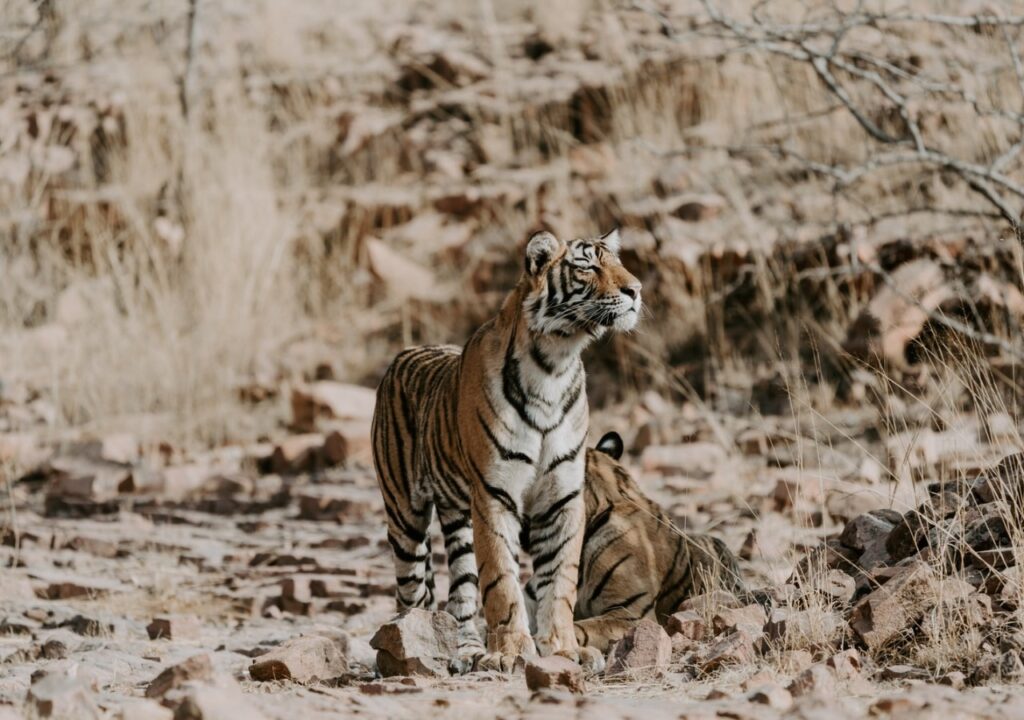According to the Tiger Census, India now has 2,967 tigers.
We were relieved to learn last month that the country’s tiger population has increased by 33% since 2014, indicating that tiger conservation is on the right track. We also owe gratitude to all those well-meaning critics from all walks of life who warned in the late 1990s that tigers would become extinct in India by the turn of the century unless the government took immediate and bold action. With 2,967 tigers, India now accounts for roughly 80% of the tigers found in the 13 Asia-Pacific tiger range countries.
The new tiger estimation method has evolved significantly since its inception in 2006, and it is now more scientifically and statistically defensible, utilizing modern animal abundance-assessment methodologies. Surveyors supplemented this with a plethora of camera traps, GPS trackers, and range-finders. Along with counting tigers, surveyors estimated the populations of a variety of co-predators and ungulate species across the country.

When pressed, surveyors could only produce drawings and plaster-casts of tiger pug-marks to back up the declared number, and state forest departments would take the brunt of the criticism. The new method, however, requires surveyors to have photographed the tigers – which they have done to an extent of 83% and the resulting 76,500+ pictures are catalogued in the Wildlife Institute of India’s tiger cell.
Tadoba Andhari Tiger Reserve is home to 88 adult tigers with another 58 tigers seen in the reserve forest nearby. Given the expanse and the resources available for these large predators, a larger population of adult tigers could be supported here in the coming years. The indigenous people and the local populace living around the forests will form the backbone of this conservation effort and protection. Red Earth Resort in Tadoba recognizes this and helps educate the people whenever possible.
Tiger age determination:

Experts have been determining the ages of tigers based on the size of the tiger in relation to its mother since 2006. While determining the age of a young tiger in the wild is difficult, local forest personnel, mahouts, and researchers working in a protected area can determine the age of a cub associated with a formerly pregnant tigress.
Tigers between the ages of 1-1.5 years almost always accompany their mothers, and experts can also estimate age based on the cub’s height in relation to its mother’s. For these exercises, they all use strategically placed camera traps. If a mother tiger has not been photographed, determining the size and age of a small tiger becomes difficult.
Based on this subjective mapping, tigers are classified as small and large cubs, juveniles, subadults, adults, primes, and old adults. These are not fixed classes and have some overlap.
The tiger has had a tumultuous conservation history in India, and there is still much work to be done to ensure that its numbers recover in a sustainable manner. We must never become complacent in our efforts to increase and sustain the tiger population for future generations. Red Earth Resort in Tadoba is committed to conservation and believes that conversation is the key, All our guests interact with our in-house naturalists who sensitize them to the various aspects of protection and conservation. All such efforts, however, small will have a snowballing effect on the health of the jungles and their inhabitants.
Some of the best-protected areas and their surrounding territorial forests in the country experienced significant population growth, as expected. Unfortunately, some of the tiger reserves did not show up any signs of tigers. Tadoba Tiger Reserve though has been able to put up a better show with a healthy increase in tiger population.
To the greatest extent possible, the government should declare only large areas to be “protected areas.” Such areas support robust wildlife ecosystems and are more likely to support large tiger populations, co-predators, and prey, as well as being less affected by human and cattle biotic pressures. In the case of a tiger reserve, the core and buffer zones should be notified and controlled by the tiger reserve management at the same time. We also need to increase capacity in protected areas at all levels and make conservation more professional. Tadoba National Park ticks all the boxes here and is a prime candidate for being a protected area for tigers which has been demonstrated successfully over the years.
Tiger conservation must prioritise protection above all else. Between January 2015 and May 2019, India lost approximately 470 tigers due to natural causes as well as poaching. The Wildlife Crime Control Bureau, which is in charge of combating organised wildlife crimes in the country, needs to be strengthened so that it can intervene directly in major tiger crimes in the states and see them through to completion.
There are still many villages within the core zones of tiger reserves. Tigers require unrestricted space and a diverse prey base, and human and cattle populations have an impact on the area’s habitability. The government should revise its relocation policies to make monetary and employment packages more appealing to villagers. Red Earth Resort in Tadoba has been pioneering this with employment opportunities at the resort and through supporting local businesses around.



